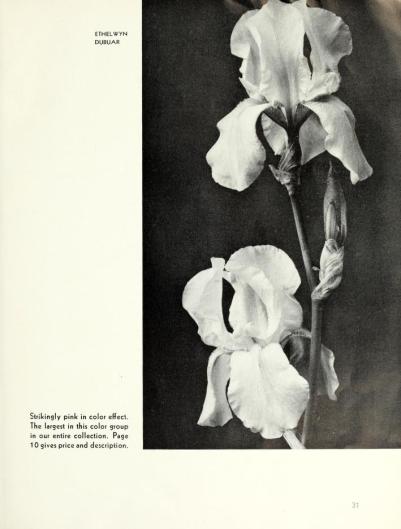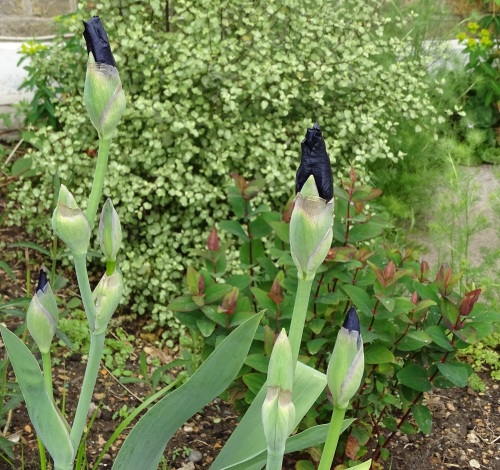
Cover of Cooley’s Gardens catalogue of irises 1935.
When Cooley’s Gardens closed its gates in 2011 after trading for over 80 years, this nursery had, in its heyday, been one of America’s leading suppliers of bearded irises. Their catalogues show dozens of iris varieties for sale that were exported as far afield as Canada, Australia, and Europe, as well as their home market in the US. Based in Oregon the nursery was the project of Rholin and Pauline Cooley and, as with many nurseries, was a hobby that in time became a business. Selling herbaceous perennials with a special focus on tall bearded irises, some of their beautiful catalogues are preserved online via the Biodiversity Heritage Library.
Like many plants, tall bearded irises go in and out of fashion. The bearded iris is probably considered by many to be too showy for today’s on trend naturalistic planting, especially as most recent cultivars have frilly edges to their petals, which combined with multicoloured flowers, makes them difficult to associate with simpler flower forms.
In 2007 gardener Sarah Cook was instrumental in reviving interest in the Benton irises, bred by the artist Cedric Morris. Developed between the 1930s and 1960s his irises display an elegance of form which modern varieties have lost, but can also be seen in the flowers from some of the Cooley’s early catalogues. The Benton varieties are grown by Beth Chatto, and seem to integrate well in her garden, amongst the grasses and other sun-loving perennials.
Looking at the Cooley’s catalogues, it’s interesting to observe how tastes in these flowers developed through the 20th century. The earlier hybrids from the 1930s have the languid look of silk gowns from that period, while by the 1950s the form of the iris flower has become more frilled, and stiffer, like prom dresses. In the process, the flowers somehow seem to lose the elegance of the earlier hybrids.
Cooley’s catalogues from the 1930s show some very elegant flowers indeed. The large black and white photographs show the spacing of the flowers on the stem, which contributes to their poise, while the colour plates show their astonishing colours from browns and purples, to pinks and pure white.

Pictured in colour Mountain Sunset and Eloise Lapham. Cooley’s Gardens catalogue 1935.

Kalinga from Cooley’s Gardens catalogue 1935.

President Pilkington, lavender blue and pale buff from 1935 catalogue.

Venus de Milo (all white) and Grace Sturtevant from 1935 catalogue

Legend with rich deep claret falls and standards of deep blue 1935 catalogue.

Ethelwyn Dubuar, strikingly pink, according to the 1935 catalogue.
For their stock, the Cooleys teamed up with iris breeders, both professional and amateur, who supplied a constant stream of new varieties. New introductions were expensive (some priced at as much as $20) and aimed at the serious collector, but this was balanced by ‘Bargains for Beginners’ and ‘Class for the thrifty’ where 12 plants of established varieties could be purchased for two dollars.

Ormohr from 1939 catalogue.

Copper Lustre from 1939 catalogue.

Far West from 1939 catalogue.

Dogrose, Legend and Rameses from the 1939 catalogue.

Itasca from the 1939 catalogue.

Treasure Island from the 1939 catalogue.

Kalinga from the 1939 catalogue.

Ethelwyn Dubuar (pink) with Red Dominion, 1939 catalogue.

Rebellion, 1939 catalogue.

1930s evening gown (Wikimedia Commons)

Irises from 1964 showing a more upright form with frilly petals

Irises from 1965
I’ve grown the deep purple flowered iris ‘Matinata’ for many years and love to see the dark, almost black, buds at this time of year, followed by the spectacular flowers. This iris was bred by Schreiner’s in the 1960s, another Oregon based iris specialist. Given the renaissance of interest in the Benton irises, perhaps it’s time to re-discover some more heritage iris varieties for our gardens.


I have been trying to find ‘San Jose’ for years. It was classified as a brown iris, but is probably more like butterscotch.
LikeLike